|
Alphabetical List |
|
|
|
|
|
|
|
County List and Topics |
|
|
|
Please sign my Guestbook and leave feedback |
|
The pages in this series are the result of an epic church crawl I undertook over one Bank Holiday weekend in 2019. Such is the richness of the mediaeval art concentrated in this area of Herefordshire, Shropshire and Worcestershire that I ask whether this might not be the “World’s Best Church Crawl”? Maybe you know a better one? I don’t personally but then this itinerary by design plays to the palette of mediaeval art that I love best. So I don’t expect everyone else to agree! Nevertheless, if you are a fan or even a casual browser on this site then I think you will agree that is a very special itinerary indeed. Perhaps you might follow it yourself and if you do you will also see an England that many feel no longer exists: an England of tiny villages and hamlets, narrow uncrowded roads, beautiful scenery and a discernibly slower pace of life. Above all a timeless England that gives the perspective of time on our present fevered political furore. The churches are all “open” (at the time of writing). All you need is a map (you will still need one even if you have sat-nav - you have been warned), a few nights accommodation, stamina and - unless you are as lucky as I was - a good waterproof! Please buy Church Guides and postcards and make donations. This is the best free show on earth: you can afford to be generous. Always sign guest books: visitor numbers are valuable collateral when churches apply for financial grants. Be grateful to those who prefer not to bow to mindless criminality or faceless insurance companies and keep their treasures accessible to all. There are some churches, often the very best and most unmissable such as Kilpeck, that were not part of this Church Crawl because I had visited them before. Where this is the case I will show where it might fit into a fuller itinerary. Each church is described briefly supplemented by some uncaptioned photographs. Click on the bottom of each description to see the associated gallery of more numerous, larger and fully captioned photographs. |
|
|
|
If you have been and are following this trail in my tyre tracks then you will have just left Fownhope (see The World’s Greatest Church Trail II) and you will be heading for Rowlestone. However, this is the point at which you MUST divert to Kilpeck. If I could save only one church in England it would be Kilpeck and I suspect that many church enthusiasts would agree with me. It is the masterpiece of Romanesque art in England and the nonpareil of the Herefordshire School. You might also wish to make a further but still eminently manageable diversion to Garway. It too is a personal favourite although you will see no Norman treasures here. It is a church that belonged in turn to the Knights Templars and the Knights Hospitaller and has the added thrill of a massive tower that was designed as a defensive bastion on the England/Wales border. These two churches were amongst my earliest subjects on this website and it would be insanity not to divert from this trail at least to Kilpeck. Kilpeck is only a couple of miles of the A465 that will be part of the AA Route Planner route from from Fownhope to Rowlestone. Garway is a further seven miles soulh of Kilpeck. Rowlestone is seven miles north west of Garway. The only reason for Kilpeck and Garway not having been on my Tewkesbury itinerary is that I had already visited each three times previously - whihc ought to be telling you something! |
|
|
|
Distance from Tewkesbury: 37 Miles West; Distance from Fownhope (Stage 10): 16 Miles South West |
|
|
|
Distance from Kilpeck : 7 Miles South |
|
Stage 14 - Rowlestone (Herefordshire) - St Peter |
|||||||||||||||||||||||||||||||||||||||||||||||||||||||||||||||
|
Why I Visited: Herefordshire School Sculptures Simon Jenkins: Excluded |
|||||||||||||||||||||||||||||||||||||||||||||||||||||||||||||||
|
Distance from Tewkesbury: 42 Miles West Distance from Garway (Stage 12) : 7 Miles North West |
|||||||||||||||||||||||||||||||||||||||||||||||||||||||||||||||
|
Although this is Stage 13 of my trail, it is only stage 11 of my actual itinerary - I have inserted the unmissable Kilpeck and Garway that I had visited previously. So this is “only” Stage 6 of the second day - sorry if that’s a bit confusing. The point is that I visited a gruelling ten churches in this one day on long summer days and in lovely weather. Twelve in one day is barely feasible so really you need to plan your own overnight stops. I only stayed every night in Tewkesbury because I had to - lovely as it is. Of all the twenty five churches on this trail Rowlestone was the most memorable for me. It is a simple Norman church (again) but the carving by the Herefordshire School sculptors here is memorably beautiful and in my opinion second only to nearby Kilpeck, although others will have different views on this. Rowlestone’s church was not mentioned in the Domesday survey of 1086. Today’s church dates from the mid-twelfth century and at that time comprised only the nave and chancel that we see today. The east wall was replaced in the fifteenth century. A west tower was added in the late sixteenth and that was pretty well it until a modern south porch was added. There are several original Norman windows to be seen here but nobody would travel far for the architecture to be seen here. This church is all about the south door and the chancel arch that were sculpted with glorious vigour by the Herefordshire School. The tympanum shows Christ in Majesty. He is giving a benediction and behind his head is a cruciform halo. Four angels hang on to the surrounding mandorla as if for dear life! The capitals are adorned with whimsical decorations including birds. Intriguing as this south doorway is, I was more stunned by the chancel arch capitals and their abaci that extend as far as the nave walls on either side. Being interior sculptures they are beautifully preserved. Birds are the recurring decorative theme here and they make for a lovely William Morris-like frieze. Pevsner seemed to agree with my own assessment calling doorway and arch decoration “two of the very best and most characteristic pieces of the Herefordshire School....” |
|||||||||||||||||||||||||||||||||||||||||||||||||||||||||||||||
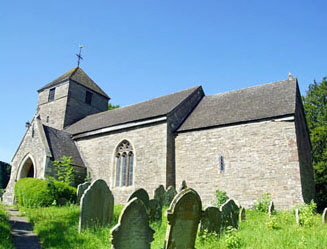 |
|||||||||||||||||||||||||||||||||||||||||||||||||||||||||||||||
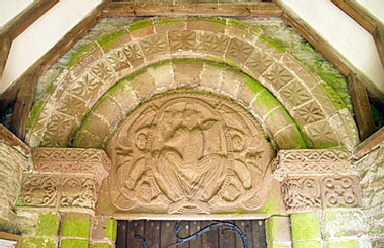 |
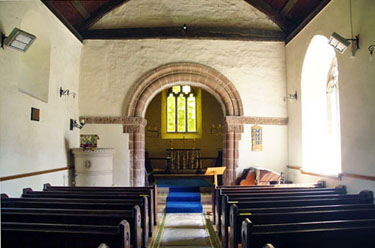 |
||||||||||||||||||||||||||||||||||||||||||||||||||||||||||||||
|
Stage 15 - Dore Abbey (Herefordshire) - Holy Trinity & St Mary |
|||||||||||||||||||||||||||||||||||||||||||||||||||||||||||||||
|
Why I Visited: Beautiful Early English Architecture Simon Jenkins: **** |
|||||||||||||||||||||||||||||||||||||||||||||||||||||||||||||||
|
Distance from Rowlestone: 4 Miles North |
|||||||||||||||||||||||||||||||||||||||||||||||||||||||||||||||
|
Dore Abbey is set in the village of Abbey Dore and if that doesn’t confuse you then I can tell you that it did me! It is not the easiest place to spot so do your homework. Much as I love Norman work and the Herefordshire School, it will make a nice change to talk about a church that is not Norman but Early English. Of course, it has not been an abbey since Thomas Cromwell did Henry VIII’s dirty work for him and all of the monastic buildings and a considerable amount of the abbey church itself have been lost. What remains, however, is a wonderful exemplar of Early English architecture built by the prestigious Cistercian Order. Having see all those little Norman village churches, Dore Abbey (in Abbey Dore) gives you a startling little primer in just how revolutionary this, the first English gothic style, was. You will see also that historiated decorative sculpture such as you see at Rowlestone abruptly disappears at Dore. I will be discussing just why this happened in the Gallery. What remains is a building of somewhat peculiar shape It makes little sense until you realise that the entire original nave was demolished. The south door entrance leads you into the south transept. With the north transept and the original crossing area it forms today’s west end of the church. The business part of the church is all housed within the original chancel. It is all rather reminiscent of Breedon-on-the-Hill church in Leicestershire. The crossing area was almost certainly beneath a central tower that was demolished. Today’s tower dates only to 1633 and sits somewhat awkwardly in the corner of the south transept and the chancel. Externally it all looks slightly untidy. Inside, however, it is magnificent. There are not too many churches around that are entirely in the Early English style. Often we see EE additions to Norman buildings or EE that has been subsequently polluted by later styles. Sometimes it gets jumbled with old Romanesque features and is better described as Transitional Dore Abbey, though, is Early English through and through. Since my early days of church visiting I have believed that there is nothing more dignified and graceful than pure early English and Dore Abbey has all of that and its east end is of cathedral-like magnificence. EE is a style that can only be appreciated as a whole piece: fragments just don’t have the same effect. Yes, the demolitions have made the west end a little untidy at Dore but once you put that behind you, you will I am sure find Dore a welcome break from bijou Norman. So what remains are the transepts and chancel, all dating from around 1170 onwards. So too the small chapels to the east of each transept. Early in the thirteenth century the chancel was extended eastwards. Aisles were built either side of the chancel continuing as an ambulatory behind the altar. A sacristy was added north of the north transept and this too survives. |
|||||||||||||||||||||||||||||||||||||||||||||||||||||||||||||||
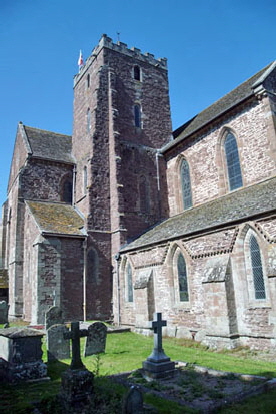 |
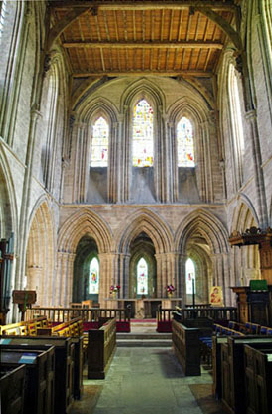 |
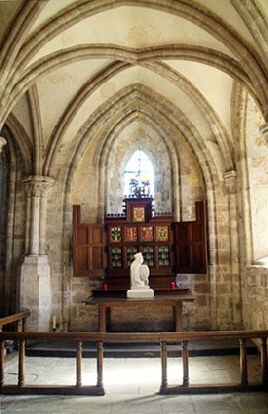 |
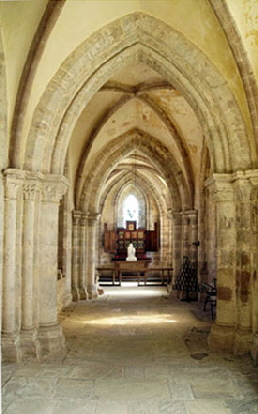 |
||||||||||||||||||||||||||||||||||||||||||||||||||||||||||||
|
Stage 16 - Eaton Bishop (Herefordshire) - St Michael & All Angels |
|||||||||||||||||||||||||||||||||||||||||||||||||||||||||||||||
|
Why I Visited: Famous Decorated Period Stained Glass Simon Jenkins: * |
|||||||||||||||||||||||||||||||||||||||||||||||||||||||||||||||
|
Distance from Abbey Dore: 8 Miles North East |
|||||||||||||||||||||||||||||||||||||||||||||||||||||||||||||||
|
Like most of the churches on this Trail, Eaton Bishop is at heart a Norman structure. Its uncompromising foursquare west tower tells you that straight away. Pevsner’s prose was mostly dry as dust but he was capable of using the most startlingly apposite of adjectives and he describes the later broach spire her as “friendly” where I might have said “squat”! It has Early English aisles of the narrowest of proportions - almost as if the masons had decided to make them just wide enough to accommodate lancet windows at their extremities. The chancel was rebuilt in the early fourteenth century. I am surprised at the lack of comment upon its five light window in the nave high above the chancel arch. Such windows are rare outside of the Cotswolds. Taken overall. however, pleasant as this church is, its architecture, frankly, would not be worth any kind of diversion in this county of Norman gems. There is absolutely no Norman sculpture by the Herefordshire School, the Dymock School or any other school, public or private! What you come to Eaton Bishop for is the glass in the fourteenth century chancel. Of this Simon Jenkins asked if the glass here is“best kept a secret?” Well, you will forgive me for sharing it with you. I am not an afficionado of stained glass being generally repelled by the gaudy industrial stuff produced in the nineteenth century and which is too often perceived by the undiscerning as “beautiful”. Mediaeval glass is altogether different. No coloured glass was produced in England at this time and it was, therefore, damnably expensive and far too precious to be worked on by anyone without artistic talents. At eaton Bishop we see compositions of delicacy, humanity and - dare I say it - spirituality. You know what? Let’s not witter on about the run-of-the-mill architecture but have a gander at the glass! |
|||||||||||||||||||||||||||||||||||||||||||||||||||||||||||||||
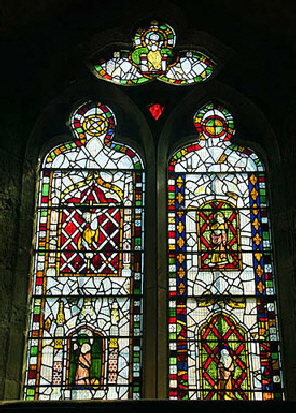 |
|||||||||||||||||||||||||||||||||||||||||||||||||||||||||||||||
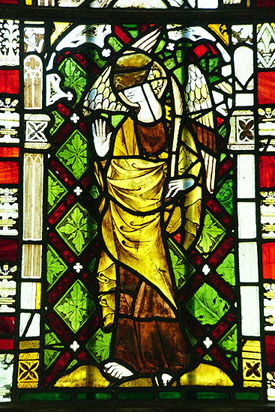 |
|||||||||||||||||||||||||||||||||||||||||||||||||||||||||||||||
 |
|||||||||||||||||||||||||||||||||||||||||||||||||||||||||||||||
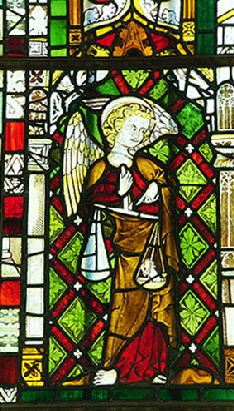 |
|||||||||||||||||||||||||||||||||||||||||||||||||||||||||||||||
|
Stage 17 - Burghill (Herefordshire) - St Mary |
|||||||||||||||||||||||||||||||||||||||||||||||||||||||||||||||
|
Why I Visited: Norman Font Simon Jenkins: Excluded |
|||||||||||||||||||||||||||||||||||||||||||||||||||||||||||||||
|
Distance from Eaton Bishop: 10 Miles North East |
|||||||||||||||||||||||||||||||||||||||||||||||||||||||||||||||
|
Without insulting Burghill Church if there was one stage that you needed to omit from your itinerary this might be it. Sorry, Burghill! On the other hand if you are visiting Brinsop (the next stage and with Herefordshire School carvings) then from there Burghill is en route to Hereford or Tewkesbury where you might well be staying overnight. So do drop by because for me it was the end of a long day and I don’t think I have really done it justice. This is yet another church of Norman origins. It was heavily restored in the nineteenth century and in truth there is little here that harks back to its early origins. Besides the font, however, there is an original Norman window in the north wall of the chance and a simple north door. There is evidence that the north arcade was late also late Norman and this is supported by a west window to this aisle that is an Early English lancet. Much of the rest is fourteenth and fifteenth century. Let’s however not spend too much time on the structure itself which is pleasant inside if somewhat austere outside. The font is a lead bowl which is mounted on a Norman stone stem with thirteen recesses containing thirteen battered images, presumably of Christ and the Twelve Apostles. Oddly, we can be pretty sure of this because such a comprehensive loss of features strongly suggestions Reformation or Commonwealth iconoclasm. The loss of other detail suggests that it also spent some time in the churchyard or a ditch. Such was the regular fate of Norman fonts. In 1810 a tower collapse damaged the lead bowl. It was eventually repaired. Just how much it was repaired is hard to know. Pevsner claims that the decorated top of the bowl is of around 1200 and this accords with the view that it was the thin lower part of the bowl that was damaged in the roof fall. Fascinatingly, then, this font was a hybrid of decorated stone and lead - a very unusual artifact indeed. Also of note here is a nice fifteenth alabaster effigy of Sir John Milbourne and his wife and also a very attractive fifteenth century timber rood screen. |
|||||||||||||||||||||||||||||||||||||||||||||||||||||||||||||||
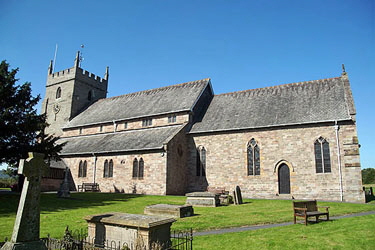 |
|||||||||||||||||||||||||||||||||||||||||||||||||||||||||||||||
 |
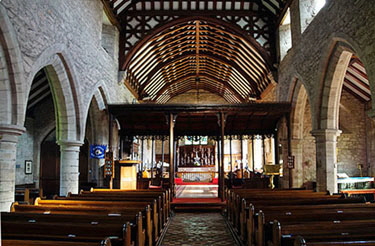 |
||||||||||||||||||||||||||||||||||||||||||||||||||||||||||||||
|
Stage 18 - Brinsop (Herefordshire) - St George |
|||||||||||||||||||||||||||||||||||||||||||||||||||||||||||||||
|
Why I Visited: Herefordshire School Carvings Simon Jenkins: * |
|||||||||||||||||||||||||||||||||||||||||||||||||||||||||||||||
|
Distance from Burghill: 3 Miles West Distance from Tewkesbury: 34 Miles West |
|||||||||||||||||||||||||||||||||||||||||||||||||||||||||||||||
|
As we come to the end of my Day 2 (and, who knows, some of you might even have followed in my tyre tracks) it is a remarkable fact that you will still only be 28 miles from Upleadon in Gloucestershire - the first church on this day’s itinerary yet you will have visited twelve remarkable churches. And you will be pretty knackered! Don’t try this in the Winter is my advice. This church is another that has work of the Herefordshire School as its principal feature but it is not a Norman church. The present fabric dates probably from 1300-1350. The Herefordshire School work tells us there was a church here in about 1150. Domesday tell us there was one here even before that, probably of wood and thatch. Of that first stone building we can point only to the simple font and to some evidence of the original walls on the north side of the chancel. That Norman church was probably a simple rectangle. Now there is a nave, a north aisle and a chancel but this is still a very simple church. Architecturally it will not long detain us. The doorway joining the north aisle to the vestry, however, survives from the old church and its arch is composed of voussoirs (that is, individual stones) with carvings in the very best traditions of Christian-Pagan schizophrenia. Voussoir carving of this kind is not typical of the Herefordshire School - it is much more common in Yorkshire for example - although some of the motifs themselves are.familiar especially on doorway capitals. It can be seen, however, at Kilpeck and, as we shall see, Shobdon. Disappointingly, some of the carvings are on the wrong side of the locked door and are not, therefore, visible although the church does display photographs. The voussoir trick is repeated above the Norman tympanum preserved as part of the wall a few feet away. It shows the familiar figure of St George (to whom this church is dedicated) slaughtering the dragon. There are many of the symbolic devices of the School visible in this picture. Design elements and styles on this tympanum have excited quite a lot of scholarly discussion about possible sources and “influences”. Some of it is really interesting and plausible, some of it somewhat esoteric and fanciful - I will discuss a bit of this in the Gallery. There is also a separate square carved panel with four circles inhabited with birds that are clearly from the same aviary as those at Rowlestone (above). The Norman church was clearly richly-decorated. |
|||||||||||||||||||||||||||||||||||||||||||||||||||||||||||||||
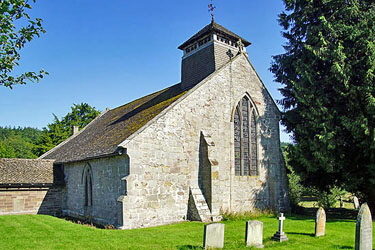 |
|||||||||||||||||||||||||||||||||||||||||||||||||||||||||||||||
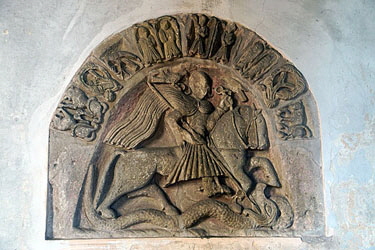 |
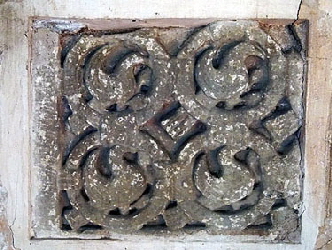 |
||||||||||||||||||||||||||||||||||||||||||||||||||||||||||||||